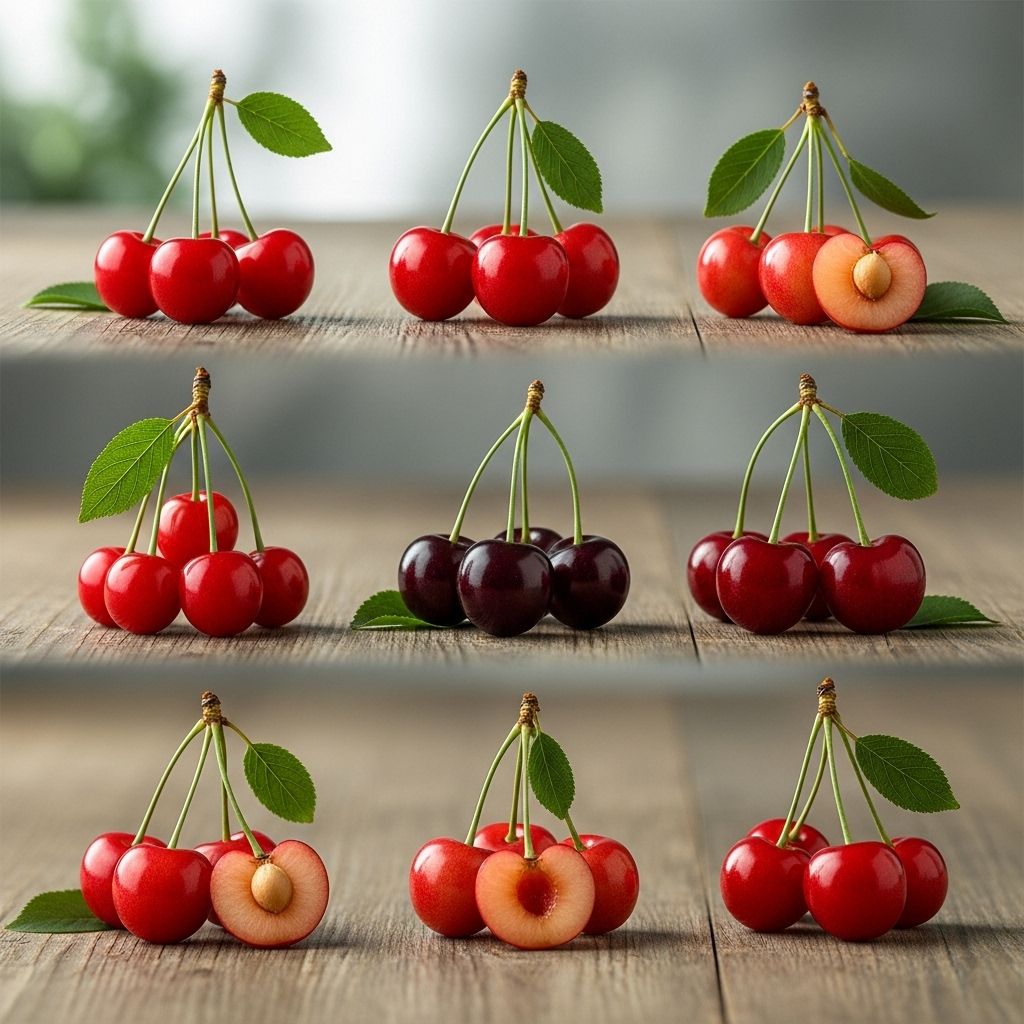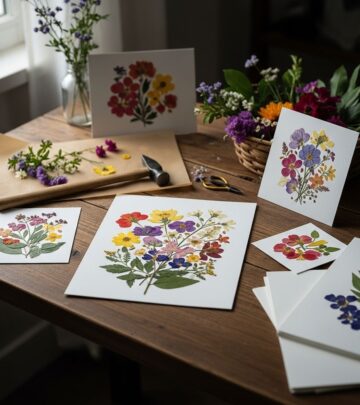10 Popular Cherry Varieties: Taste, Uses, and Tips
Each juicy summer fruit offers a distinct taste and ideal pairing to elevate dishes.

Cherries are a cherished summer fruit, celebrated for their juicy flavor, vibrant hues, and diverse culinary applications. Whether you prefer them sweet or tart, raw or cooked, there is a cherry variety for every palate and purpose. This guide explores 10 of the most renowned types of cherries, with tips on identifying them, savoring their unique flavors, and making the most of cherry season.
What Are Cherries?
Cherries are small, fleshy stone fruits (drupes) that grow on trees in the genus Prunus. They are divided into two main categories:
- Sweet Cherries (Prunus avium): Best eaten fresh, commonly used in desserts and salads.
- Tart or Sour Cherries (Prunus cerasus): Known for their sharp flavor, traditionally used in baking, preserves, and juice.
The flavor, color, and size of cherries vary widely depending on the variety, as do their culinary uses. Let’s discover the most popular types and what makes each one special.
1. Bing Cherries
Bing cherries are the most recognizable dark sweet cherries in North America. Heart-shaped with a glossy, deep red to purplish-black skin, they are noted for their firm and juicy flesh.
- Flavor: Intensely sweet, rich, and juicy with a slightly tangy finish.
- Color: Deep red to almost black.
- Best for: Snacking, desserts, salads, and freezing.
- Nutrition: High in antioxidants and anti-inflammatory compounds.
Available fresh during late spring to early summer, Bing cherries are equally delicious in baked goods or right from the bowl.
2. Rainier Cherries
Named after Mount Rainier in Washington State, Rainier cherries stand out with their distinctive golden-yellow skin and blushes of red. They are prized for their delicate sweetness and pleasing texture.
- Flavor: Exceptionally sweet, sometimes with subtle floral notes.
- Color: Bright yellow with red blush.
- Best for: Fresh eating, salads, cheese boards, and garnishes.
- Notes: Higher sugar content than Bing; short harvest season and more expensive.
Rainier cherries bruise easily, so handle with care. Their sweetness makes them perfect for enjoying raw or pairing with creamy cheeses and nuts.
3. Chelan Cherries
Originating from Washington State, Chelan cherries resemble Bing in appearance but ripen up to two weeks earlier, making them a welcome harbinger of cherry season.
- Flavor: Firmly sweet but milder than Bing, gentle tannins for balance.
- Color: Very dark red, glossy.
- Best for: Snacking, salads, and early summer recipes.
- Notes: Hardy trees, often one of the first sweet cherries harvested.
The mild sweetness makes Chelan cherries versatile and a great introduction for those new to fresh cherry eating.
4. Queen Anne (Royal Ann) Cherries
Queen Anne cherries (also called Royal Ann) are renowned for their attractive yellow skin with a red blush and a notably tart flavor profile that sets them apart from their visual twin, the Rainier.
- Flavor: Bright, tart, and juicy.
- Color: Pale golden yellow with rosy red cheeks.
- Best for: Making maraschino cherries, canning, and preserves.
- Notes: Often turned into the vibrantly red maraschino cherries that top desserts and cocktails.
Don’t mistake Queen Anne cherries for Rainiers; the tartness makes them ideal for both sweet and savory recipes.
5. Montmorency Cherries
Montmorency cherries are the iconic sour cherry variety commonly used in pies, tarts, and preserves. Their vibrant red color and sharp flavor make them a classic choice for bakers.
- Flavor: Tart, tangy, and juicy with a robust cherry essence.
- Color: Bright red skin with yellow flesh.
- Best for: Baking, preserves, sauces, juice, and dried cherries.
- Notes: Most tart cherry products in the U.S. feature Montmorency cherries.
Montmorency’s assertive flavor holds up well to sugar and heat—perfect for cherry pie or classic cherry jam.
6. Tulare Cherries
Tulare cherries are a relative newcomer, discovered just decades ago in Tulare, California. These cherries bridge the gap between sweet and tart, making them a versatile choice for kitchen creativity.
- Flavor: A balanced mix of sweet and tangy—ideal for snacking or cooking.
- Color: Deep red, similar to Bing cherries.
- Best for: Snacking, baking, savory dishes (like pork or salsa), and chutneys.
Use Tulare cherries in both sweet and savory recipes—they add a juicy flair to chutneys and salsas as well as classic baked goods.
7. Sweetheart Cherries
Sweetheart cherries are a late-season variety popular for their large size, crisp texture, and reliably sweet taste. They extend the cherry season for enthusiasts looking to enjoy fresh cherries well into summer.
- Flavor: Sweet and mildly tart with a satisfying crunch.
- Color: Bright to deep red.
- Best for: Snacking, salads, and desserts.
- Notes: Self-fertile trees that yield abundantly late in the season.
Thanks to their firm flesh, Sweetheart cherries hold up beautifully for eating out of hand or as a fresh pastry topping.
8. Black Cherries
Black cherries (a category encompassing types like Bing and Chelan) are known for their luscious, near-black hue and rich, dark-sweet flavor. While commonly used for fresh eating, these cherries shine in culinary applications as well.
- Flavor: Intense sweetness with a robust, wine-like finish.
- Color: Deep crimson to almost black.
- Best for: Snacking, desserts, sauce, and preserves.
- Notes: Look for vibrant color and firm flesh for the best eating experience.
Due to their deep color, black cherries are loaded with anthocyanins and make beautiful, vividly colored sauces and reductions.
9. Amarelle Cherries
Amarelle cherries are a subcategory of tart cherries, pale in color and distinctly sharp in flavor. They’re a favorite for old-fashioned cherry pies and candied cherries.
- Flavor: Light, lemony tartness with a subtle cherry note.
- Color: Pale to bright red skin; clear, yellowish flesh.
- Best for: Pies, preserves, candied cherries, and cooking.
- Notes: Less common at the grocery store; look for Amarelles at farmers’ markets or orchards.
Their clear flesh and bracing tartness are valued in traditional home-style baking and confectionery.
10. Morello Cherries
Morello cherries are another class of sour cherries, with distinctively dark red to purple skin and juice. They are the top choice for European cherry desserts and preserves because of their dramatic color and piquant flavor.
- Flavor: Deeply tart, slightly bitter, and robust.
- Color: Dark red to purple skin and flesh.
- Best for: Classic cherry cakes, Black Forest cake, preserves, and liqueurs.
- Notes: Intensely pigmented; stains easily, so handle carefully.
Morello cherries are famous in clafoutis (French baked cherry desserts) and for making cherry brandy and jams that pack a punch.
Choosing and Storing Cherries: Tips for Peak Freshness
- Choose cherries that are firm, glossy, and free of bruises or mold.
- Stems should be green and flexible, indicating freshness.
- Refrigerate cherries unwashed in a breathable container. Rinse just before eating.
- For best flavor, allow cherries to come to room temperature before enjoying.
- Freeze pitted cherries in a single layer and then transfer to freezer bags for year-round use.
Cherries are highly perishable; consume within a few days or preserve for longer enjoyment.
Table: Cherry Varieties Quick Reference
| Variety | Color | Flavor | Best Uses |
|---|---|---|---|
| Bing | Deep red to black | Sweet, rich | Snacking, desserts |
| Rainier | Yellow with red blush | Exceptionally sweet | Fresh eating, salads |
| Chelan | Dark red | Mildly sweet | Early season snacking |
| Queen Anne | Pale yellow-red | Tart, juicy | Maraschino cherries, canning |
| Montmorency | Bright red | Tart, tangy | Pies, preserves |
| Tulare | Deep red | Sweet-tart | Baking, savory, snacking |
| Sweetheart | Bright red | Sweet, crisp | Snacking, desserts |
| Black Cherries | Dark red-black | Rich, wine-like | Eating, sauces |
| Amarelle | Pale-red | Very tart | Pies, preserves |
| Morello | Dark red-purple | Tart, robust | Cakes, liqueurs |
Fun Ways to Use Cherries
- Fresh snacking: Enjoy by the handful, chilled.
- Baking: Cherry pies, galettes, clafoutis, and muffins.
- Preserves & Jams: Use tart varieties for a balanced, bright spread.
- Cocktails: Garnish with Queen Anne maraschino cherries or muddle black cherries for vibrant flavor.
- Salads: Toss fresh cherries with greens, goat cheese, and nuts for a summery salad.
- Sauces: Cook cherries down to make sauces for meat, poultry, or ice cream.
Frequently Asked Questions (FAQs)
Q: How can you tell the difference between sweet and tart cherry varieties?
A: Sweet cherries (like Bing or Rainier) are typically larger, firmer, and eaten fresh, while tart cherries (such as Montmorency or Morello) are smaller, softer, and more often used in cooked or preserved forms due to their sharper flavor.
Q: Why are Rainier cherries more expensive?
A: Their thin skin, short season, and delicate handling requirements increase production costs, while limited supply boosts demand during their brief harvest window.
Q: What makes cherries red, yellow, or black in color?
A: Cherry color comes from different natural pigments. Red and black cherries have high levels of anthocyanins—antioxidant pigments—while yellow cherries like Rainier have less pigment, resulting in their golden hue.
Q: Can you use sweet cherries in pies instead of tart cherries?
A: You can use sweet cherries for pie, but you may need to decrease the sugar in your recipe or add a splash of lemon juice for balance. Tart cherries are traditional for pies because their acidity withstands the cooking process.
Q: Are maraschino cherries made from one particular cherry type?
A: Most traditional maraschino cherries are made from Queen Anne or Royal Ann cherries, brined and then sweetened and dyed for the familiar look and flavor.
Cherry Selection, Storage, and Inspiration
Cherries embody summer’s fleeting sweetness—from bold, juicy Bings to punchy tart Montmorency and ethereal Raniers. When picking cherries, look for plump, glossy fruit with flexible stems, and store unwashed in the refrigerator for up to a week.
From backyard snacking to show-stopping pies, the array of cherry varieties ensures you’ll always find the perfect fruit for any recipe. Celebrate cherry season by sampling new types, trying inventive uses, and perhaps planting a tree for future harvests!
References
- https://www.ediblearrangements.com/blog/types-of-cherries/
- https://smartcherry.world/agronomic-management/varieties/cherry-varieties-their-characteristics-tips-and-how-to-recognize-them/
- https://www.thepioneerwoman.com/food-cooking/cooking-tips-tutorials/g35786867/types-of-cherries/
- https://www.tastingtable.com/971914/types-of-cherries-explained/
- https://www.stemilt.com/stem-blog/cherry-varieties-compared-whats-the-difference/
Read full bio of Sneha Tete












